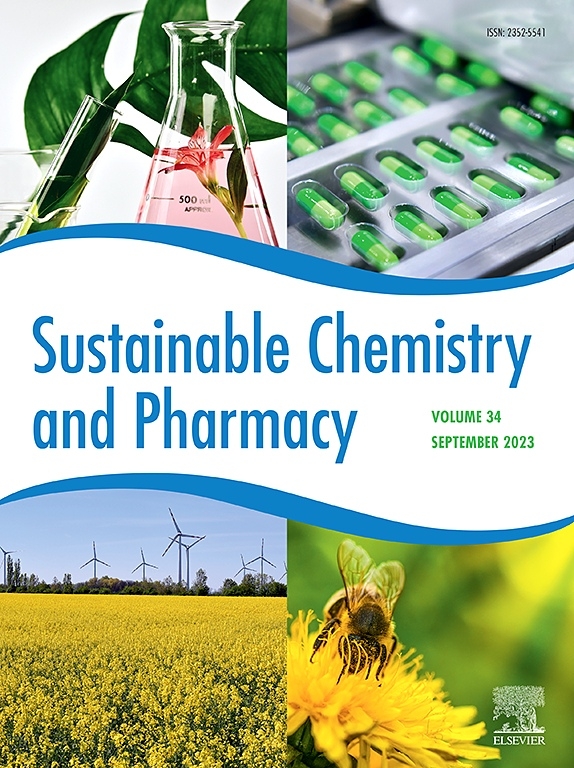土耳其药用植物天然药物对castellanacanthamoeba的杀阿米巴作用及dna保护作用
IF 5.8
2区 化学
Q2 CHEMISTRY, MULTIDISCIPLINARY
引用次数: 0
摘要
棘阿米巴感染是重大的公共卫生问题,特别是棘阿米巴角膜炎(AK)和肉芽肿性阿米巴脑炎(GAE)。尽管采用了化学疗法,但这些感染的治疗效果往往有限。人们迫切需要替代疗法,药用植物因其疗效和可持续性而成为一种有希望的天然疗法来源。从土耳其Ordu地区采集的荨麻、黑德拉和藜草叶片中提取乙醇提取物。植物材料冷冻干燥,研磨,并在乙醇中提取,最终提取物调整为45 mg/ml。不同浓度对棘阿米巴滋养体的作用时间分别为24、48和72 h,通过台锥蓝染色评估其活力。使用MTT(3-(4,5 -二甲基噻唑-2-il)-2,5-二苯尼四唑溴)测定法评估HeLa细胞的细胞毒性。采用pBR322质粒DNA孵育植物提取物,电泳检测DNA保护作用。提取物具有剂量依赖性的杀阿米巴活性,72 h的IC50值分别为12.5、28和9.8 mg/ml,其中最高浓度(45 mg/ml)表现出最显著的效果。细胞毒性实验显示,HeLa细胞的IC50值分别为3.372、1.735和2.417 mg/ml。此外,植物提取物对羟基自由基诱导的pBR322质粒DNA损伤具有保护作用,类似于DNA保护剂Torolox。这些发现表明,杜鹃花、双螺旋花和杜鹃花乙醇提取物作为棘阿米巴感染和癌症的治疗药物具有重要的潜力,是一种天然的、可持续的替代品。本文章由计算机程序翻译,如有差异,请以英文原文为准。

Amoebicidal effects against Acanthamoeba castellanii and DNA-protective activities of natural remedies derived from Turkish medicinal plants
Acanthamoeba infections represent significant public health concerns, particularly Acanthamoeba keratitis (AK) and granulomatous amoebic encephalitis (GAE). Despite chemical-based therapies, these infections often show limited therapeutic success. There is a pressing need for alternative treatments, and medicinal plants have emerged as a promising source of natural therapeutics due to their efficacy and sustainable properties.
Urtica dioica, Hedera helix, and Chenopodium album ethanol extracts were prepared from leaves collected in Ordu, Turkey. Plant material was freeze-dried, ground, and extracted in ethanol, with final extracts adjusted to 45 mg/ml. Various concentrations were tested on Acanthamoeba castellanii trophozoites for 24, 48, and 72 h, assessing viability via Trypan Blue staining. Cytotoxicity was evaluated in HeLa cells using the MTT (3-(4, 5-dimetiltiazol-2-il)-2,5-difeniltetrazolium bromide) assay. DNA protection was tested by incubating plant extracts with pBR322 plasmid DNA, followed by electrophoresis.
The extracts exhibited dose-dependent amoebicidal activity, with IC50 values of 12.5, 28, and 9.8 mg/ml at 72 h, with the highest concentration (45 mg/ml) demonstrating the most substantially effect. Cytotoxicity assays revealed IC50 values of 3.372, 1.735, and 2.417 mg/ml for HeLa cells. Additionally, the plant extracts exhibited protective effects against hydroxyl radical-induced DNA damage in pBR322 plasmid DNA, similar to the DNA-protective agent Torolox. These findings suggest that U. dioica, H. helix, and C. album ethanol extracts have significant potential as therapeutic agents for Acanthamoeba infections and cancer, offering a natural and sustainable alternative.
求助全文
通过发布文献求助,成功后即可免费获取论文全文。
去求助
来源期刊

Sustainable Chemistry and Pharmacy
Environmental Science-Pollution
CiteScore
8.20
自引率
6.70%
发文量
274
审稿时长
37 days
期刊介绍:
Sustainable Chemistry and Pharmacy publishes research that is related to chemistry, pharmacy and sustainability science in a forward oriented manner. It provides a unique forum for the publication of innovative research on the intersection and overlap of chemistry and pharmacy on the one hand and sustainability on the other hand. This includes contributions related to increasing sustainability of chemistry and pharmaceutical science and industries itself as well as their products in relation to the contribution of these to sustainability itself. As an interdisciplinary and transdisciplinary journal it addresses all sustainability related issues along the life cycle of chemical and pharmaceutical products form resource related topics until the end of life of products. This includes not only natural science based approaches and issues but also from humanities, social science and economics as far as they are dealing with sustainability related to chemistry and pharmacy. Sustainable Chemistry and Pharmacy aims at bridging between disciplines as well as developing and developed countries.
 求助内容:
求助内容: 应助结果提醒方式:
应助结果提醒方式:


